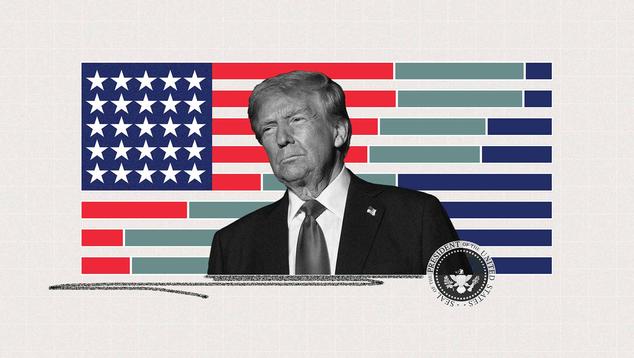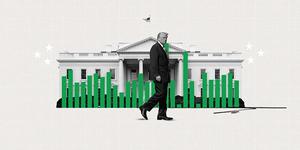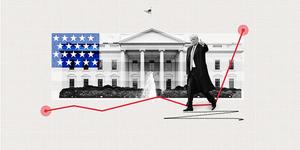WASHINGTON, D.C. — President Donald Trump is closing out the first quarter of his second term in office with an average 45% job approval rating, higher than the 41% earned in his first term but well below all other post-World War II presidents elected in the U.S. The average first-quarter rating for all presidents elected from 1952 to 2020 is 60%.
John F. Kennedy and Dwight Eisenhower had the highest first-quarter average ratings, with both registering above 70%, while Jimmy Carter, Barack Obama and Ronald Reagan averaged between 60% and 69%. George W. Bush, George H.W. Bush, Joe Biden and Bill Clinton had similar average ratings of 55% to 58% in their first quarters. Trump is the only president to have sub-50% average approval ratings during a first quarter in office.
Trump’s first-quarter average for his second term includes his latest 44% approval rating, from an April 1-14 poll, with 53% of Americans currently disapproving of the way he is handling his job. This is in line with the previous three readings during his second term. Of these, his highest individual approval rating this year was the first one — 47% in January.
Partisans’ ratings of Trump are stable, with 90% of Republicans and 4% of Democrats expressing approval of the president’s job performance. Independents’ current 37% approval has been steady since February but is nine percentage points lower than their inaugural rating of Trump.
The latest poll was conducted during a period of economic turbulence in the U.S. as positive employment and gross domestic product reports in early April were overshadowed by Trump's announcement of sweeping tariffs on April 2. Those tariffs triggered a sharp stock market decline. Despite a temporary 90-day pause on some tariffs by Trump on April 9 and the easing of other terms since then, market instability has persisted. Some economists warn of a potential recession, citing declining consumer confidence, volatile markets and signs of slowing growth.
Americans Have Subpar Confidence in Leaders on the Economy
Amid the economic uncertainty in April, 44% of U.S. adults say they have confidence in Trump to recommend or do the right thing for the economy, including 30% with “a great deal” of confidence and 14% with “a fair amount.” Meanwhile, a majority of Americans indicate they have either “only a little” confidence in the president (11%) or “almost none” (44%).
Trust in the economic judgment of all other U.S. leaders rated in the poll is weaker than for Trump, with fewer than four in 10 Americans saying they have a great deal or fair amount of confidence in the Republican leaders in Congress in general (39%), Federal Reserve Chairman Jerome Powell (37%), Republican Speaker of the House Mike Johnson (36%) and Senate Republican Leader John Thune (33%).
Public confidence in U.S. Democratic leaders’ economic handling is even lower, including for House Democratic Leader Hakeem Jeffries (30%), Senate Democratic Leader Chuck Schumer (25%) and the Democratic leaders in Congress in general (25%).
Majorities of Americans have only a little or almost no confidence in the economic management of each of the leaders included in the poll except for Powell, doubted by 50%, because he garners the highest “no opinion” rating (14%).
Republicans Broadly Confident in GOP Leaders; Democrats Less So in Theirs
As has been the case in recent years, Americans’ views of whom they trust to do the right thing on the economy reflect deep partisan divisions, with little crossover support for leaders of the opposing party.
Trump commands the highest level of in-party support, with 89% of Republicans saying they have a great deal (67%) or fair amount (22%) of confidence in him on the economy, compared with 37% of independents and 8% of Democrats. Other Republican leaders — including congressional leaders in general and Johnson and Thune, specifically — also earn majority-level confidence from Republicans but far less from independents (25% to 29%) and Democrats (7% to 16%).
Conversely, Democrats express less confidence than Republicans in their own party’s congressional leadership (39%), Jeffries (50%) and Schumer (48%). Independents have more confidence in Jeffries than the others on the Democratic side — but even that is muted, at 29%. No more than 18% of Republicans have confidence in any of the Democratic leaders.
Powell earns more confidence from Republicans (43%) than Democrats (37%) or independents (32%).
Trump’s Economic Confidence Rating Similar to First-Term Average
Gallup has tracked public confidence in presidents’ handling of the economy every year since the younger Bush took office in 2001. Bush, Obama and Biden all began their terms with majority-level confidence, while Trump received 48% in the first year of his first presidential term. His current 44% rating is similar to the 46% average throughout his first term.
The highest economic confidence ratings were for Bush in 2002 and Obama in 2009 (73% and 71%, respectively). The lowest ratings for economic management were for Bush in 2008 (34%) amid the Great Recession and for Biden in 2023 (35%) as high inflation continued to plague Americans.
Powell’s Rating on the Economy Remains Historically Low
Powell, who has led the Federal Reserve since 2018 after being nominated by Trump, has seen his economic confidence readings stagnate in recent years. This year’s 37% rating is similar to those from the previous two years. Powell’s only majority-level ratings were 58% in 2020 and 55% in 2021, during the COVID-19 pandemic that wreaked havoc on the U.S. economy. High inflation beginning in late 2021 and lasting into 2023 is likely at least partly behind Powell’s lower ratings in recent years.
Alan Greenspan, who served five terms in the position, inspired majority-level confidence in each of Gallup’s five readings between 2001 and 2005. In contrast, the two Fed chairs who followed Greenspan — Ben Bernanke and Janet Yellen — failed to register confidence ratings above 50%.
The president nominates the Fed chair for a four-year term. Powell’s leadership has spanned presidential administrations of both parties, as he was nominated by Trump in 2017 and reappointed by Biden in 2021. During Trump’s first term, more Republicans than Democrats expressed confidence in Powell, but the opposite was true during Biden’s administration. Once again, under Trump, Republicans now have more confidence in him than Democrats do. Independents’ confidence in Powell has been less affected by the president’s party and seemingly more so by economic conditions in the U.S.
Democratic Congressional Leaders’ Rating at Record Low
Democratic leadership’s latest 25% confidence rating is an all-time low for the group — well below the previous 34% low recorded in 2023 and the average of 45% since 2001. In contrast, Republican leadership’s latest 39% rating is well above the 24% low for that group in 2014 after a federal government shutdown, but not far from the historical average of 43%.
Confidence ratings were last at the majority level in 2009 for Democratic congressional leaders and in 2003 for Republican congressional leaders.
Democratic congressional leaders’ rating among their own party faithful has fallen 41 points since last year to their lowest point ever. The previous low for Democratic congressional leaders among Democrats was 60%, recorded in 2005. For their part, Republicans’ confidence in their own party’s congressional leaders has never fallen below 42%.
Bottom Line
Trump averaged a 45% job approval rating in the first quarter of his second term — slightly better than his first term but well below post-World War II presidential norms. Confidence in his economic leadership remains low at 44%, though it surpasses ratings for other U.S. leaders, including those in Congress and at the Federal Reserve. Republicans’ confidence in their party’s economic leadership is strong, while Democrats’ confidence in their own party’s leadership is historically low.
Explore President Trump’s approval ratings and compare them with those of past presidents in the Gallup Presidential Job Approval Center.
To stay up to date with the latest Gallup News insights and updates, follow us on X @Gallup.
Learn more about how the Gallup Poll Social Series works.
View complete question responses and trends (PDF download).




